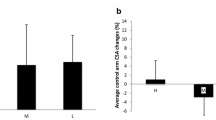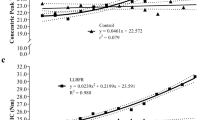Abstract
Purpose
Muscular strength is suggested to be dependent upon muscle characteristics. Yet, sex-specific relationships of muscle characteristics to strength in the resistance-trained require investigation. Therefore, the purpose was to evaluate sex differences in muscle characteristics and isometric strength in the elbow extensors, as well as their respective associations.
Methods
Resistance-trained men (n = 15, mean ± SD 22 ± 4 years, 87.5 ± 12.8 kg, 16.9 ± 2.9% body fat) and women (n = 15, mean ± SD 25 ± 5 years, 59.3 ± 7.3 kg, 22.4 ± 4.2% body fat) were tested. B-mode ultrasound images assessed muscle thickness, pennation angle, and echo intensity. Muscle volume and fascicle length were estimated from previously validated equations. Maximal voluntary isometric contraction measured elbow extensors isometric strength. Independent samples t-tests and Fisher’s r-to-z test examined differences between sexes.
Results
Sex differences existed in all muscle characteristics (p < 0.05). Men’s absolute strength (27.86 ± 3.55 kg) was significantly greater than women (16.15 ± 3.15 kg), but no differences were noted when controlling for muscle volume (men 0.069 ± 0.017, women 0.077 ± 0.022 kg/cm3). Sex differences did not exist in the relationships of muscle characteristics to strength with muscle size having the largest correlations. However, the relationship between echo intensity and body fat was different in men (r = − 0.311) and women (r = 0.541, p = 0.0143).
Conclusions
Sex differences in isometric elbow extensor strength are eliminated when expressed relative to muscle volume. Relationships of echo intensity and body fat were different between men and women and may be indicative of greater adipose infiltration in women.


Similar content being viewed by others
Abbreviations
- EI:
-
Echo intensity
- DXA:
-
Dual energy X-ray absorptiometry
- FL:
-
Fascicle length
- LBM:
-
Lean body mass
- LL:
-
Limb length
- MT:
-
Muscle thickness
- MV:
-
Muscle volume
- PA:
-
Pennation angle
- US:
-
Ultrasound imaging
References
Abe T, Brechue WF, Fujita S, Brown JB (1998) Gender differences in FFM accumulation and architectural characteristics of muscle. Med Sci Sports Exerc 30(7):1066–1070. https://doi.org/10.1097/00005768-199807000-00007
Arts IMP, Pillen S, Schelhaas HJ et al (2010) Normal values for quantitative muscle ultrasonography in adults. Muscle Nerve 41:32–41. https://doi.org/10.1002/mus.21458
Bolsterlee B, Gandevia SC, Herbert RD (2016) Effect of transducer orientation on errors in ultrasound image-based measurements of human medial gastrocnemius muscle fascicle length and pennation. PLoS One 11:e0157273. https://doi.org/10.1371/journal.pone.0157273
Caresio C, Molinari F, Emanuel G, Minetto MA (2015) Muscle echo intensity: reliability and conditioning factors. Clin Physiol Funct Imaging 35:393–403. https://doi.org/10.1111/cpf.12175
Cohen J (1988) Statistical power analysis for the behavioral sciences. Lawrence Earlbaum Associates. Hilsdale
Delmonico MJ, Harris TB, Visser M et al (2009) Longitudinal study of muscle strength, quality, and adipose tissue infiltration. Am J Clin Nutr 90:1579–1585. https://doi.org/10.3945/ajcn.2009.28047
Dudley GA, Harris RT, Duvoisin MR et al (1990) Effect of voluntary vs. artificial activation on the relationship of muscle torque to speed. J Appl Physiol 69:2215–2221
Ema R, Wakahara T, Mogi Y et al (2013) In vivo measurement of human rectus femoris architecture by ultrasonography: validity and applicability. Clin Physiol Funct Imaging 33:267–273. https://doi.org/10.1111/cpf.12023
Fukumoto Y, Ikezoe T, Tateuchi H et al (2012a) Muscle mass and composition of the hip, thigh and abdominal muscles in women with and without hip osteoarthritis. Ultrasound Med Biol 38:1540–1545. https://doi.org/10.1016/j.ultrasmedbio.2012.04.016
Fukumoto Y, Ikezoe T, Yamada Y et al (2012b) Skeletal muscle quality assessed from echo intensity is associated with muscle strength of middle-aged and elderly persons. Eur J Appl Physiol 112:1519–1525
Fukunaga T, Kawakami Y, Kuno S et al (1997) Muscle architecture and function in humans. J Biomech 30:457–463. https://doi.org/10.1016/S0021-9290(96)00171-6
Fukunaga T, Miyatani M, Tachi M et al (2001) Muscle volume is a major determinant of joint torque in humans. Acta Physiol Scand 172:249–255
Fukutani A, Kurihara T (2015) Comparison of the muscle fascicle length between resistance-trained and untrained individuals: cross-sectional observation. SpringerPlus. https://doi.org/10.1186/s40064-015-1133-1
Haizlip KM, Harrison BC, Leinwand LA (2015) Sex-based differences in skeletal muscle kinetics and fiber-type composition. Physiology 30:30–39. https://doi.org/10.1152/physiol.00024.2014
Ichinose Y, Kanehisa H, Ito M et al (1998) Morphological and functional differences in the elbow extensor muscle between highly trained male and female athletes. Eur J Appl Physiol 78:109–114. https://doi.org/10.1007/s004210050394
Ikegawa S, Funato K, Tsunoda N et al (2008) Muscle force per cross-sectional area is inversely related with pennation angle in strength trained athletes. J Strength Cond Res 22:128–131
Ivey FM, Tracy BL, Lemmer JT et al (2000) Effects of strength training and detraining on muscle quality age and gender comparisons. J Gerontol Ser A 55:B152–B157. https://doi.org/10.1093/gerona/55.3.B152
Kawakami Y, Abe T, Fukunaga T (1993) Muscle-fiber pennation angles are greater in hypertrophied than in normal muscles. J Appl Physiol Bethesda Md 1985 74:2740–2744
Kawakami Y, Abe T, Kuno S-Y, Fukunaga T (1995) Training-induced changes in muscle architecture and specific tension. Eur J Appl Physiol 72:37–43. https://doi.org/10.1007/BF00964112
Kawakami Y, Abe T, Kanehisa H, Fukunaga T (2006) Human skeletal muscle size and architecture: Variability and interdependence. Am J Hum Biol 18:845–848. https://doi.org/10.1002/ajhb.20561
Kubo K, Kanehisa H, Azuma K et al (2003) Muscle architectural characteristics in young and elderly men and women. Int J Sports Med 24:125–130. https://doi.org/10.1055/s-2003-38204
Liu G, Li J, Zhou H et al (2016) A simple way to improve the relative and absolute reliability of handheld dynamometer measurements using learners. Int J Clin Exp Med 9:199–208
Manal K, Roberts DP, Buchanan TS (2006) Optimal pennation angle of the primary ankle plantar and dorsiflexors: variations with sex, contraction intensity, and limb. J Appl Biomech 22:255–263
Miller AE, MacDougall JD, Tarnopolsky MA, Sale DG (1993) Gender differences in strength and muscle fiber characteristics. Eur J Appl Physiol 66:254–262
Miyaguchi K, Demura S (2009) Gender difference in ability using the stretch-shortening cycle in the upper extremities. J Strength Cond Res 23:231–236
Miyatani M (2004) The accuracy of volume estimates using ultrasound muscle thickness measurements in different muscle groups. Eur J Appl Physiol 91:264–272. https://doi.org/10.1007/s00421-003-0974-4
Muraki S, Fukumoto K, Fukuda O (2013) Prediction of the muscle strength by the muscle thickness and hardness using ultrasound muscle hardness meter. SpringerPlus 2:1–7
Nana A, Slater GJ, Stewart AD, Burke LM (2015) Methodology review: using dual-energy X-ray absorptiometry (DXA) for the assessment of body composition in athletes and active people. Int J Sport Nutr Exerc Metab 25:198–215. https://doi.org/10.1123/ijsnem.2013-0228
Ogasawara R, Thiebaud RS, Loenneke JP et al (2012) Time course for arm and chest muscle thickness changes following bench press training. Interv Med Appl Sci 4:217–220. https://doi.org/10.1556/IMAS.4.2012.4.7
Pillen S, Tak RO, Zwarts MJ et al (2009) Skeletal muscle ultrasound: correlation between fibrous tissue and echo intensity. Ultrasound Med Biol 35:443–446. https://doi.org/10.1016/j.ultrasmedbio.2008.09.016
Rech A, Radaelli R, Goltz FR et al (2014) Echo intensity is negatively associated with functional capacity in older women. AGE. https://doi.org/10.1007/s11357-014-9708-2
Trexler ET, Smith-Ryan AE, Roelofs EJ, Hirsch KR (2015) Body composition, muscle quality, and scoliosis in female collegiate gymnasts. Int J Sports Med 36:1087. https://doi.org/10.1055/s-0035-1555781
Watanabe Y, Yamada Y, Fukumoto et al (2013) Echo intensity obtained from ultrasonography images reflecting muscle strength in elderly men. Clin Interv Aging. https://doi.org/10.2147/CIA.S47263
Weeks BK, Gerrits TA, Horan SA, Beck BR (2016) Muscle size not density predicts variance in muscle strength and neuromuscular performance in healthy adult men and women. J Strength Cond Res 30:1577–1584
Acknowledgements
There was no funding received for this work, nor relationships with companies or manufacturers who will benefit from the results of this study.
Author information
Authors and Affiliations
Contributions
JM and MJ conceived and designed research. JM, JW, and EH conducted experiments. JO, JW, and JS analyzed data. JM, MJ, JW wrote the manuscript. All authors read and approved the manuscript.
Corresponding author
Ethics declarations
Conflict of interest
The authors have no conflict of interest.
Additional information
Communicated by William J. Kraemer.
Rights and permissions
About this article
Cite this article
Merrigan, J.J., White, J.B., Hu, Y.E. et al. Differences in elbow extensor muscle characteristics between resistance-trained men and women. Eur J Appl Physiol 118, 2359–2366 (2018). https://doi.org/10.1007/s00421-018-3962-4
Received:
Accepted:
Published:
Issue Date:
DOI: https://doi.org/10.1007/s00421-018-3962-4




